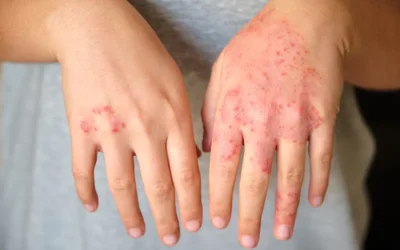Regarded as a common and complex form of arthritis, gout causes sudden pain, redness, swelling, and stiffness in the joints. The condition is caused by the buildup of crystals made of a substance called uric acid in your joints. Factors that increase the uric acid level in your body include diet, obesity, certain medications, age and medical conditions. Generally, affecting the joint at the base of the big toe, gout attacks can be painful and can occur suddenly, often waking patients in the middle of the night. These attacks keep returning over time, slowly harming tissues in the region of the inflammation. It can also cause lumps under the skin and kidney stones. The affected joint becomes swollen and tender that even the weight of a cloth on it may seem to be intolerable. If left untreated, the condition can become chronic. Hard lumps (called tophi) can eventually develop in your joints and the skin and soft tissue surrounding them, which can permanently damage the joints. Accurate diagnosis and medical billing and coding of this complex form of arthritis can be challenging. Physicians treating this condition need to be familiar with the specific ICD-10 codes and outsourcing medical billing and coding to an experienced service provider is a reliable strategy to ensure this.
Gout is the most common form of inflammatory arthritis in men. However, it can also affect women most probably after the menopause. The condition occurs when urate crystals accumulate in your joint, causing the inflammation and intense pain of a gout attack. Urate crystals can form when you have high levels of uric acid in your blood. In normal cases, uric acid dissolves in your blood and passes through the kidneys into the urine. But, when the body produces too much uric acid, it can build up, forming sharp, needle-like urate crystals in a joint or surrounding tissue that cause pain, inflammation and swelling.
Identifying the Symptoms
The signs and symptoms of gout, in most cases occur suddenly, and often at night. Some of the common symptoms include –
- Lingering discomfort
- Intense joint pain
- Inflammation and redness
- Limited range of motion
Other potential risk factors associated with the condition include – consuming a diet rich in meat and seafood, drinking beverages sweetened with fruit sugar (fructose), certain diseases like – untreated high blood pressure and chronic conditions such as diabetes, metabolic syndrome, and heart and kidney diseases, use of certain type of medications, obesity and family history of gout.
Diagnosing and Treating the Causes of Gout
Early diagnosis of the symptoms of gout is crucial as crystals within the joint can lead to joint damage. Physicians, after evaluating the history of symptoms, will perform a thorough physical examination to identify the painful areas. A blood test will be done to measure the levels of uric acid and creatinine in the patient’s blood. Joint fluid test will also be done to draw fluid from the affected joint. Other additional tests include – X-rays, Ultrasound and Dual energy CT scan.
Treatment for gout usually involves medications which include Corticosteroids and Non-steroidal Anti-inflammatory Drugs (NSAIDS). Physical therapy modalities like – Transcutaneous Electrical Nerve Stimulation (TENS), Ice or heat will be recommended to eliminate muscle spasm and inflammation. Ultrasound will be performed to improve joint mobility.
Orthopedic surgeons, podiatrists and other specialists who treat Gout rely on reputable medical billing companies for accurate documentation. ICD-10 codes for gout come under the M10 code category. ICD-10 codes for diagnosing Gout include –
M10 Gout
- M10.0 Idiopathic gout
- M10.00 Idiopathic gout, unspecified site
- M10.01 Idiopathic gout, shoulder
- M10.02 Idiopathic gout, elbow
- M10.03 Idiopathic gout, wrist
- M10.04 Idiopathic gout, hand
- M10.05 Idiopathic gout, hip
- M10.06 Idiopathic gout, knee
- M10.07 Idiopathic gout, ankle and foot
- M10.1 Lead-induced gout
-
- M10.10 Lead-induced gout, unspecified site
- M10.11 Lead-induced gout, shoulder
- M10.12 Lead-induced gout, elbow
- M10.13 Lead-induced gout, wrist
- M10.14 Lead-induced gout, hand
- M10.15 Lead-induced gout, hip
- M10.16 Lead-induced gout, knee
- M10.17 Lead-induced gout, ankle and foot
- M10.18 Lead-induced gout, vertebrae
- M10.19 Lead-induced gout, multiple sites
- M10.2 Drug-induced gout
-
- M10.20 Drug-induced gout, unspecified site
- M10.21 Drug-induced gout, shoulder
- M10.22 Drug-induced gout, elbow
- M10.23 Drug-induced gout, wrist
- M10.24 Drug-induced gout, hand
- M10.25 Drug-induced gout, hip
- M10.26 Drug-induced gout, knee
- M10.28 Drug-induced gout, vertebrae
- M10.29 Drug-induced gout, multiple sites
- M10.3 Gout due to renal impairment
-
- M10.30 Gout due to renal impairment, unspecified site
- M10.31 Gout due to renal impairment, shoulder
- M10.32 Gout due to renal impairment, elbow
- M10.33 Gout due to renal impairment, wrist
- M10.34 Gout due to renal impairment, hand
- M10.35 Gout due to renal impairment, hip
- M10.36 Gout due to renal impairment, knee
- M10.37 Gout due to renal impairment, ankle and foot
- M10.38 Gout due to renal impairment, vertebrae
- M10.39 Gout due to renal impairment, multiple sites
- M10.4 Other secondary gout
-
- M10.40 Other secondary gout , unspecified site
- M10.41 Other secondary gout, shoulder
- M10.42 Other secondary gout, elbow
- M10.43 Other secondary gout, wrist
- M10.44 Other secondary gout, hand
- M10.45 Other secondary gout, hip
- M10.46 Other secondary gout, knee
- M10.47 Other secondary gout, ankle and foot
- M10.48 Other secondary gout, vertebrae
- M10.49 Other secondary gout, multiple sites
- M10.9 Gout, unspecified
Medications are often the most effective way to treat acute gout and can prevent recurrent attacks of gout. However, incorporating certain lifestyle changes like – limiting alcoholic beverages and drinks sweetened with fruit sugar, keeping one’s body at a healthy weight and limiting intake of foods high in purines, such as red meat, organ meats and seafood can help avoid the recurrence of this condition in the long run.
Relying on the services of an experienced medical coding service provider could be invaluable to document Gout correctly. Coders in reliable medical coding outsourcing companies would ensure accurate reporting of diagnostic details and this in turn will help avoid denied and delayed claims.




